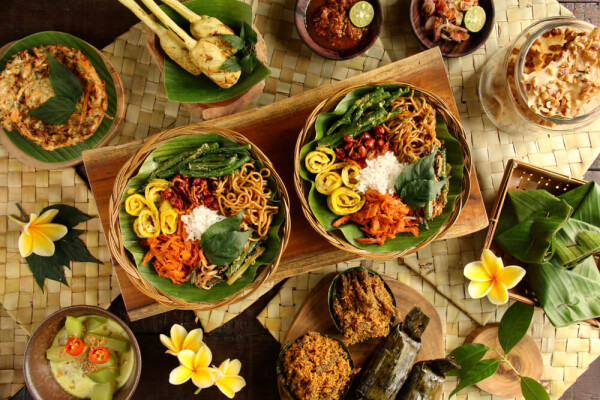Indonesia, a sprawling archipelago of over 17,000 islands, presents a culinary panorama as diverse and captivating as its myriad cultures and landscapes. Far from a monolithic entity, Indonesian cuisine is a vibrant tapestry woven from regional specificities, historical migrations, and a profound reverence for fresh, local ingredients. Each island, indeed each village, often boasts its own distinctive flavors, preparation methods, and signature dishes, making a gastronomic exploration of the nation an endless journey of delightful discovery. To truly comprehend Indonesian meals is to understand a complex interplay of spices, textures, and communal dining rituals.

The Foundations of Indonesian Fare: Rice as the Unifying Element
At the heart of virtually every Indonesian meal lies rice. This ubiquitous grain is not merely a side dish; it is the central pillar, the raison d’être around which all other culinary elements coalesce. Whether steamed white rice (nasi putih), fragrant coconut rice (nasi uduk), or turmeric-infused yellow rice (nasi kuning), its presence is axiomatic. This centrality underscores the communal nature of Indonesian dining, where dishes are often served ala carte and shared amongst diners, each scooping a portion of rice to accompany various savory accompaniments.
The Art of the Sambal: Indonesia’s Pungent Soul
No Indonesian table is complete without sambal. This fiery condiment, a piquant mélange of chilies, garlic, shallots, and various other aromatics (such as shrimp paste, tomato, or lime), is the very soul of Indonesian cuisine. Its varieties are legion, ranging from the raw, vibrant sambal matah of Bali to the robust, cooked sambal terasi found across Java. Sambal is not merely an additive; it is an intrinsic component that elevates and balances the flavors of almost every dish, providing that characteristic kick that electrifies the palate. Its nuanced heat and aromatic complexity are hallmarks of the Indonesian dining experience.
A Kaleidoscope of Regional Specialties: From Sumatra to Papua
The true marvel of Indonesian meals lies in their unparalleled regional diversity. Each island group, shaped by unique historical trajectories and geographical endowments, contributes its distinct culinary vernacular.
The Richness of Western Indonesia: Sumatran and Sundanese Delights
From Sumatra hails the robust and intensely spiced Padang cuisine, particularly the iconic Rendang. This slow-cooked beef curry, redolent with coconut milk, galangal, lemongrass, and myriad spices, is a culinary masterpiece, celebrated globally for its rich flavor and tender texture. It is a dish that epitomizes patience and precision, often taking hours to prepare. Another Sumatran gem is Martabak, a thick, savory pancake filled with spiced minced meat and eggs, served with a tangy vinegar sauce – a popular street food found late into the night.
Moving to West Java, Sundanese cuisine offers a refreshing contrast with its emphasis on fresh, raw vegetables (lalapan) served with a variety of sambals. Dishes like Nasi Timbel, rice wrapped in a banana leaf, often accompanied by fried chicken (ayam goreng), tofu, tempeh, and sambal, showcase the Sundanese penchant for fresh flavors and textures. The sweet and savory karedok, a raw vegetable salad with peanut sauce, is another prime example of their vibrant culinary style.
The Heart of the Archipelago: Javanese and Balinese Epicureanism
Java, the most populous island, offers an incredibly diverse culinary landscape. Javanese cuisine from Central Java often leans towards the sweeter side, utilizing palm sugar liberally. Gudeg, a classic dish from Yogyakarta, exemplifies this: young unripe jackfruit slow-cooked in coconut milk and palm sugar for hours, resulting in a rich, sweet, and savory stew. In East Java, flavors tend to be bolder and spicier. Rawon, a dark beef soup characterized by the use of kluwek nuts (black keluak nuts) which impart a unique earthy, slightly bitter, and umami flavor, is a prime example of East Javanese culinary prowess.
Bali, a spiritual and cultural enclave, boasts a distinct cuisine often incorporating pork and a vibrant array of spices. Babi Guling (suckling pig), slow-roasted over an open fire with a complex bumbu (spice paste) rub, is a celebratory dish of unparalleled succulence and flavor. Lawar, a mixed vegetable and meat salad with coconut and rich spices, showcases Bali’s intricate use of fresh herbs and spices, demonstrating a sophisticated balance of flavors and textures.
Eastern Horizons: Sulawesi and Beyond
As one journeys further east, the culinary narratives continue to diversify. Sulawesi’s Coto Makassar, a rich beef soup made with offal and peanuts, and Pallu Basa, another beef soup with a red chili base, exemplify the island’s robust and hearty flavors. The influence of seafood becomes increasingly prominent in coastal areas, with myriad grilled fish preparations (ikan bakar) infused with various local spices and served with fresh sambals. Even in the remote regions of Papua, traditional methods of cooking, such as baking food in heated earth pits (bakar batu), persist, offering a glimpse into ancient culinary practices.
Indonesian meals, therefore, are not merely about consumption; they are about cultural immersion. They represent a legacy of resourceful cooking, a reverence for local produce, and a profound understanding of how diverse flavors can coalesce into harmonious and unforgettable experiences. From the fiery kick of sambal to the comforting embrace of nasi and the myriad regional specialities, every meal in Indonesia is an invitation to explore a truly remarkable gastronomic archipelago.